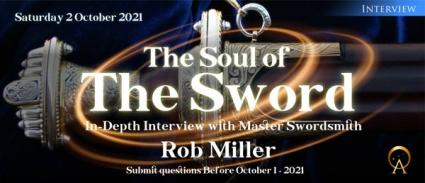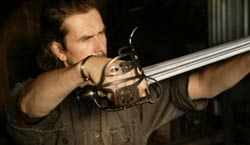
Mythology speaks of magical swords like Excalibur, Claíomh Solais, Durendal and Thuận Thiên. In history swords were not only weapons to warriors, but were also embedded with symbols of power. The four elements, earth, air, fire and water fuse in the creation of a sword. Iron ore from the earth provides the raw material, and the fire from the forge separates the iron from the oxygen releasing the air, and then the steel is tempered by water. In the blending of these four elements, the fifth ethereal element magically enters: the soul of the sword, encapsulated in the decorated blade, it sings in the hands of its wielder.
Rob Miller, Master Swordsmith comments: “My original obsession was with the alchemical nature of the whole operation, so the fire has remained at the center of my work. I see it as the essential element that is introduced into steel to give it a ‘life’, something that may not be visible to the customer, but that will give a sense of soul to the final piece.”
Rob walks us through the recreation of some of the most famous swords in history: The Canute Sword, dating to Late Viking Age, was found in Langeid in south Norway now exhibited in Oslo. It is thought to have been owned by one of King Canute’s wealthy warriors that accompanied him to fight against King Ethelred in England. The hilt is decorated in characters that suggest the influence of Christianity at this point, gold leaf work and silver wired grip compliment the striking appearance of the sword. Gold was very rarely used in Viking pieces.
The Steinvik Sword, is another Norwegian Viking treasure, found by Arnt Steinvik in Skatval, Stjørdal municipality in Norway. It is sometimes difficult to imagine how these early craftsmen were able to achieve such exquisite detail in their work, with such a short life expectancy and the lack of modern tools and equipment. The silver wires were all inlaid and hammered in, along with the intricate gripping beast panels in bronze. The grip was ornamented with a silver ring, again inlaid with the same features.
The Fetter Lane Sword is an eight century Saxon sword that was discovered during construction in Fetter Lane, London. Rob was immediately struck by the bizarre serpent design on the one side of the pommel, it looked somehow modern and ancient at the same time, and unlike anything else he had ever seen. This was the Sword that would earn him his Master’s seal.
 ROB MILLER is one of the very few remaining swordsmiths who uses traditional techniques to create entirely authentic, functional swords. This means using fire and a hammer to forge, harden and hamper the steel to give it the desired qualities of toughness and flexibility, as well as the beauty and grace of a true work of art. Based on the Isle of Skye in Scotland, Rob Miller has over 25 years’ experience forging original swords, as well as recreating historical pieces that have been recovered from battlegrounds and burials
ROB MILLER is one of the very few remaining swordsmiths who uses traditional techniques to create entirely authentic, functional swords. This means using fire and a hammer to forge, harden and hamper the steel to give it the desired qualities of toughness and flexibility, as well as the beauty and grace of a true work of art. Based on the Isle of Skye in Scotland, Rob Miller has over 25 years’ experience forging original swords, as well as recreating historical pieces that have been recovered from battlegrounds and burials
Initially, he was just interested to find out how swords could be crafted in the modern age but the production of his first few blades attracted the attention of visitors to the Island. In order to create the sword from raw materials he developed several other skill sets too: leatherwork, jewellery-making and woodwork are all required during the making of the scabbard and belt work, and the fine ornamentation of the more elaborate pieces. As one of the longer established swordsmiths worldwide Rob has gained a positive reputation for his craft.
In-depth Interviews are available to our Gold Members. (It’s easy and quick to become a Gold Member – get immediate access to interviews, webinars, free eBooks, exclusive content, and so much more!)
As a Gold Member, you get to submit your questions or points in advance. In-depth Interviews are pre-recorded, and then are available to watch at a time that’s easy and convenient to you.
